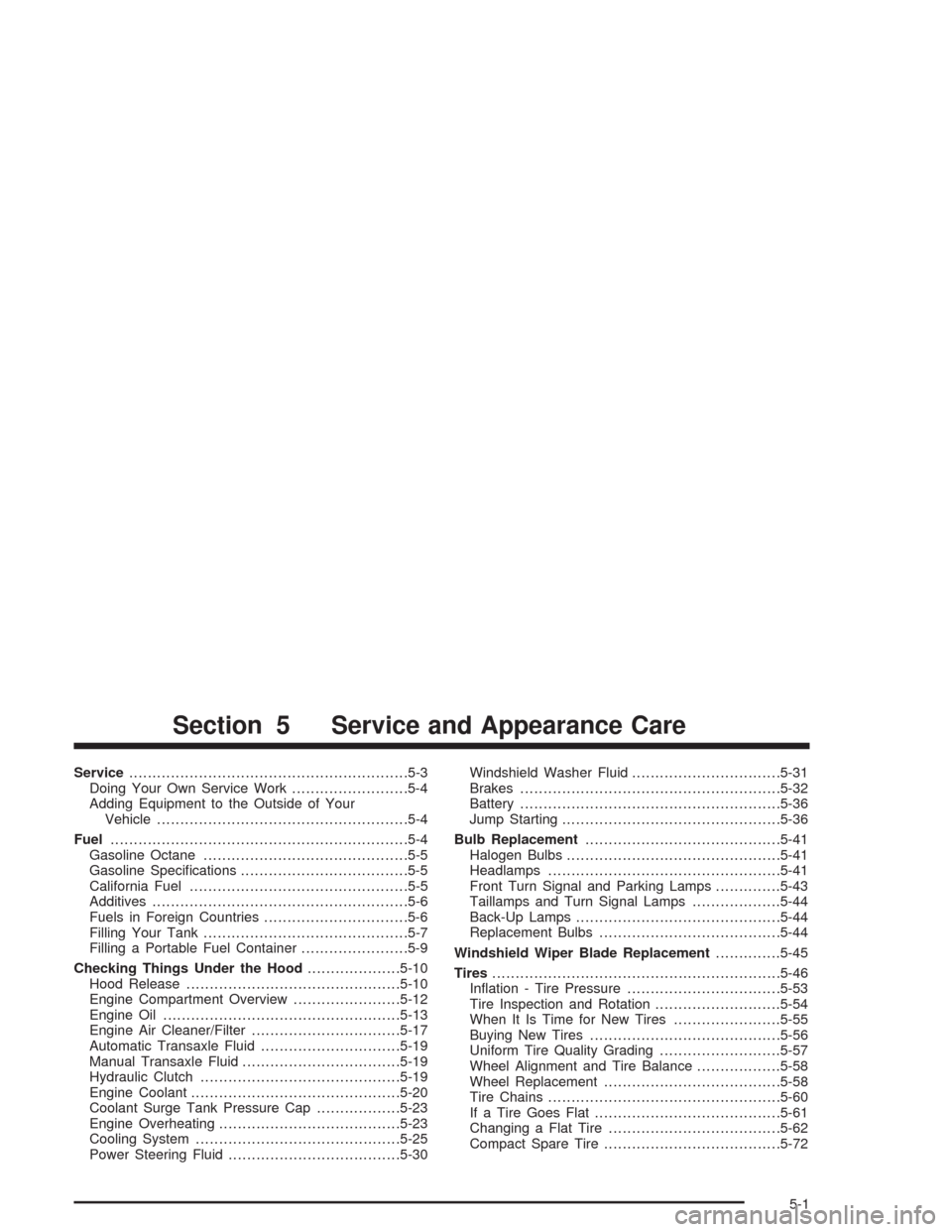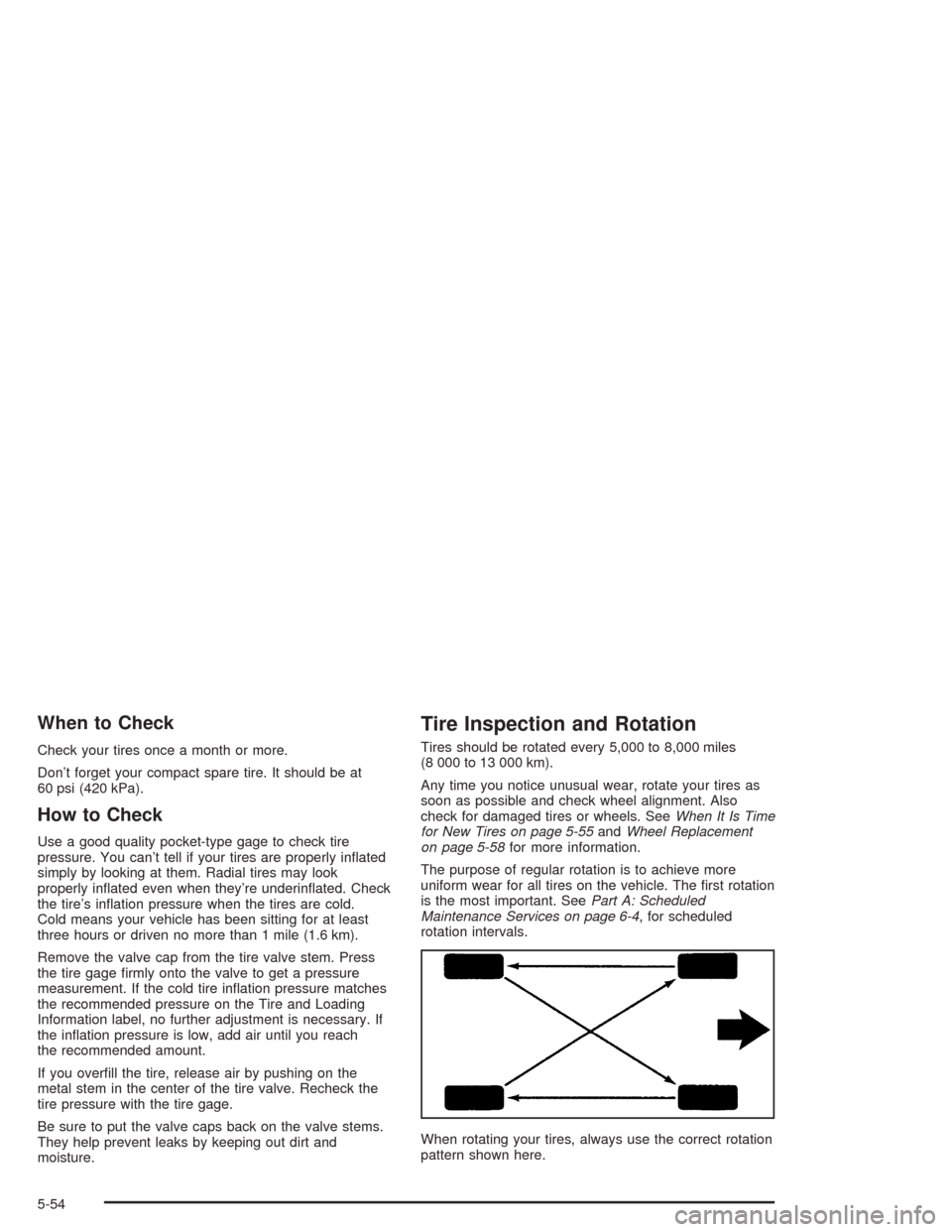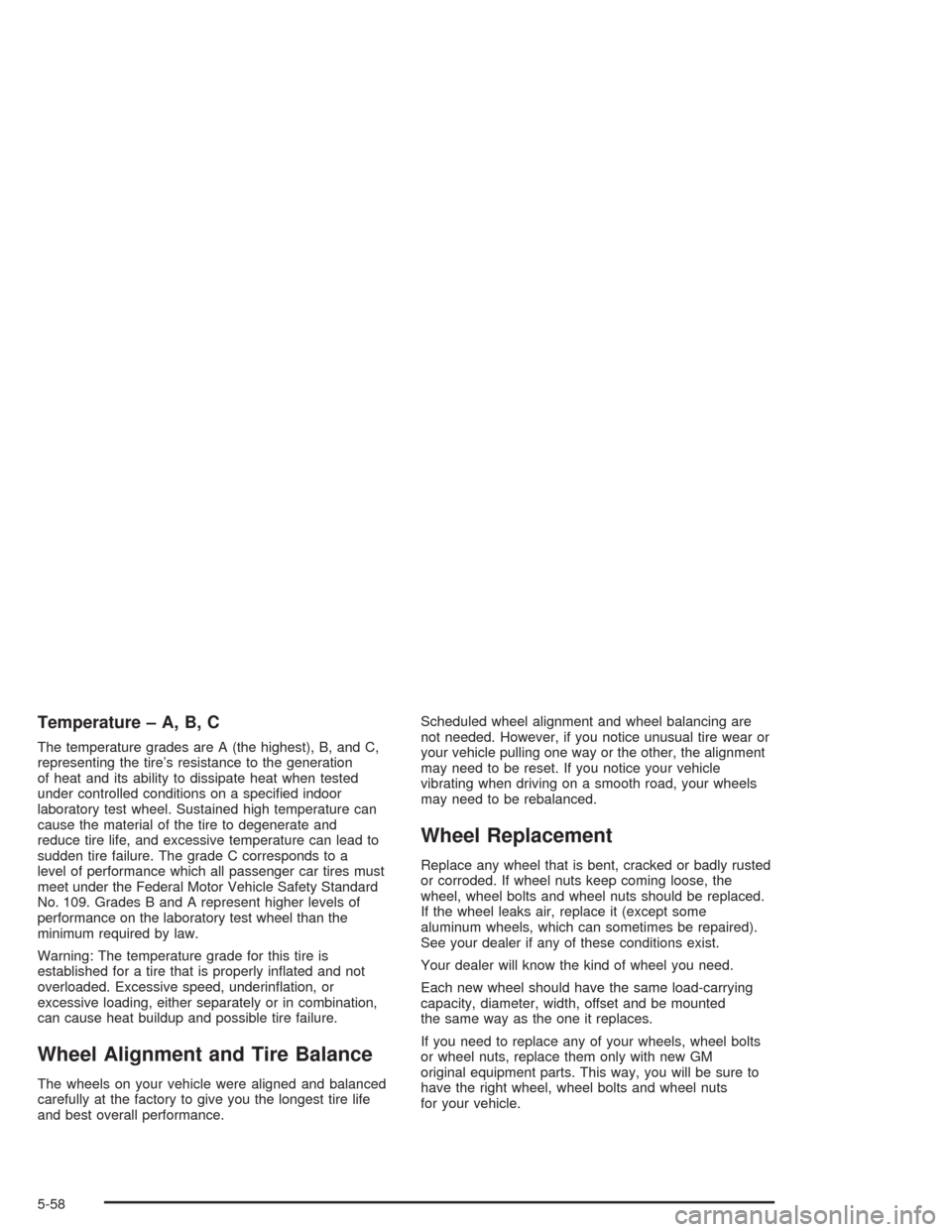2004 CHEVROLET CAVALIER wheel alignment
[x] Cancel search: wheel alignmentPage 211 of 354

Service............................................................5-3
Doing Your Own Service Work.........................5-4
Adding Equipment to the Outside of Your
Vehicle......................................................5-4
Fuel................................................................5-4
Gasoline Octane............................................5-5
Gasoline Speci�cations....................................5-5
California Fuel...............................................5-5
Additives.......................................................5-6
Fuels in Foreign Countries...............................5-6
Filling Your Tank............................................5-7
Filling a Portable Fuel Container.......................5-9
Checking Things Under the Hood....................5-10
Hood Release..............................................5-10
Engine Compartment Overview.......................5-12
Engine Oil...................................................5-13
Engine Air Cleaner/Filter................................5-17
Automatic Transaxle Fluid..............................5-19
Manual Transaxle Fluid..................................5-19
Hydraulic Clutch...........................................5-19
Engine Coolant.............................................5-20
Coolant Surge Tank Pressure Cap..................5-23
Engine Overheating.......................................5-23
Cooling System............................................5-25
Power Steering Fluid.....................................5-30Windshield Washer Fluid................................5-31
Brakes........................................................5-32
Battery........................................................5-36
Jump Starting...............................................5-36
Bulb Replacement..........................................5-41
Halogen Bulbs..............................................5-41
Headlamps..................................................5-41
Front Turn Signal and Parking Lamps..............5-43
Taillamps and Turn Signal Lamps...................5-44
Back-Up Lamps............................................5-44
Replacement Bulbs.......................................5-44
Windshield Wiper Blade Replacement..............5-45
Tires..............................................................5-46
In�ation - Tire Pressure.................................5-53
Tire Inspection and Rotation...........................5-54
When It Is Time for New Tires.......................5-55
Buying New Tires.........................................5-56
Uniform Tire Quality Grading..........................5-57
Wheel Alignment and Tire Balance..................5-58
Wheel Replacement......................................5-58
Tire Chains..................................................5-60
If a Tire Goes Flat........................................5-61
Changing a Flat Tire.....................................5-62
Compact Spare Tire......................................5-72
Section 5 Service and Appearance Care
5-1
Page 264 of 354

When to Check
Check your tires once a month or more.
Don’t forget your compact spare tire. It should be at
60 psi (420 kPa).
How to Check
Use a good quality pocket-type gage to check tire
pressure. You can’t tell if your tires are properly in�ated
simply by looking at them. Radial tires may look
properly in�ated even when they’re underin�ated. Check
the tire’s in�ation pressure when the tires are cold.
Cold means your vehicle has been sitting for at least
three hours or driven no more than 1 mile (1.6 km).
Remove the valve cap from the tire valve stem. Press
the tire gage �rmly onto the valve to get a pressure
measurement. If the cold tire in�ation pressure matches
the recommended pressure on the Tire and Loading
Information label, no further adjustment is necessary. If
the in�ation pressure is low, add air until you reach
the recommended amount.
If you over�ll the tire, release air by pushing on the
metal stem in the center of the tire valve. Recheck the
tire pressure with the tire gage.
Be sure to put the valve caps back on the valve stems.
They help prevent leaks by keeping out dirt and
moisture.
Tire Inspection and Rotation
Tires should be rotated every 5,000 to 8,000 miles
(8 000 to 13 000 km).
Any time you notice unusual wear, rotate your tires as
soon as possible and check wheel alignment. Also
check for damaged tires or wheels. SeeWhen It Is Time
for New Tires on page 5-55andWheel Replacement
on page 5-58for more information.
The purpose of regular rotation is to achieve more
uniform wear for all tires on the vehicle. The �rst rotation
is the most important. SeePart A: Scheduled
Maintenance Services on page 6-4, for scheduled
rotation intervals.
When rotating your tires, always use the correct rotation
pattern shown here.
5-54
Page 268 of 354

Temperature – A, B, C
The temperature grades are A (the highest), B, and C,
representing the tire’s resistance to the generation
of heat and its ability to dissipate heat when tested
under controlled conditions on a speci�ed indoor
laboratory test wheel. Sustained high temperature can
cause the material of the tire to degenerate and
reduce tire life, and excessive temperature can lead to
sudden tire failure. The grade C corresponds to a
level of performance which all passenger car tires must
meet under the Federal Motor Vehicle Safety Standard
No. 109. Grades B and A represent higher levels of
performance on the laboratory test wheel than the
minimum required by law.
Warning: The temperature grade for this tire is
established for a tire that is properly in�ated and not
overloaded. Excessive speed, underin�ation, or
excessive loading, either separately or in combination,
can cause heat buildup and possible tire failure.
Wheel Alignment and Tire Balance
The wheels on your vehicle were aligned and balanced
carefully at the factory to give you the longest tire life
and best overall performance.Scheduled wheel alignment and wheel balancing are
not needed. However, if you notice unusual tire wear or
your vehicle pulling one way or the other, the alignment
may need to be reset. If you notice your vehicle
vibrating when driving on a smooth road, your wheels
may need to be rebalanced.
Wheel Replacement
Replace any wheel that is bent, cracked or badly rusted
or corroded. If wheel nuts keep coming loose, the
wheel, wheel bolts and wheel nuts should be replaced.
If the wheel leaks air, replace it (except some
aluminum wheels, which can sometimes be repaired).
See your dealer if any of these conditions exist.
Your dealer will know the kind of wheel you need.
Each new wheel should have the same load-carrying
capacity, diameter, width, offset and be mounted
the same way as the one it replaces.
If you need to replace any of your wheels, wheel bolts
or wheel nuts, replace them only with new GM
original equipment parts. This way, you will be sure to
have the right wheel, wheel bolts and wheel nuts
for your vehicle.
5-58
Page 352 of 354

T
Tachometer....................................................3-22
Taillamps
Turn Signal Lamps......................................5-44
Theft-Deterrent, Radio.....................................3-67
Theft-Deterrent Systems...................................2-14
Content Theft-Deterrent................................2-14
Passlock
®...................................................2-15
Throttle System Inspection...............................6-23
Tilt Wheel........................................................ 3-5
Tire In�ation Check.........................................6-18
Tire Sidewall Labeling......................................5-46
Tire Size.......................................................5-50
Tire Terminology and De�nitions........................5-50
Tires.............................................................5-46
Buying New Tires........................................5-56
Chains.......................................................5-60
Changing a Flat Tire....................................5-62
Compact Spare Tire.....................................5-72
If a Tire Goes Flat.......................................5-61
In�ation - Tire Pressure................................5-53
Inspection and Rotation................................5-54
Uniform Tire Quality Grading.........................5-57
Wheel Alignment and Tire Balance.................5-58
Wheel Replacement.....................................5-58
When It Is Time for New Tires......................5-55
To Use the Engine Coolant Heater....................2-20
Top Strap......................................................1-38
Top Strap Anchor Location...............................1-39Torque Lock...................................................2-27
Total Weight on Your Vehicle’s Tires..................4-40
Towing
Recreational Vehicle.....................................4-29
Towing a Trailer..................................4-37, 4-43
Your Vehicle...............................................4-29
Traction
Enhanced Traction System (ETS).................... 4-8
Enhanced Traction System (ETS)
Active Light.............................................3-28
Enhanced Traction System (ETS) Warning
Light......................................................3-27
Trailer Brakes.................................................4-40
Transaxle
Fluid, Automatic...........................................5-19
Fluid, Manual..............................................5-19
Transaxle Operation, Automatic.........................2-20
Transaxle Operation, Manual............................2-23
Transmission
Up-Shift Light..............................................3-25
Transmission, Transaxle, Transfer Case Unit
Repair Manual............................................7-12
Transportation Options...................................... 7-8
Trap-Resistant Trunk Kit...................................2-12
Trip Odometer................................................3-22
Trunk............................................................2-10
Turn and Lane-Change Signals.......................... 3-6
Turn Signal/Multifunction Lever........................... 3-6
Turn Signals When Towing a Trailer..................4-41
14
Page 353 of 354

U
Underbody Flushing Service.............................6-22
Understanding Radio Reception........................3-67
Uniform Tire Quality Grading............................5-57
United States – Customer Assistance.................. 7-4
Up-Shift Light.................................................3-25
Used Replacement Wheels..............................5-59
Using an MP3 CD..........................................3-61
Using Cleaner on Fabric..................................5-73
Using the Rear Door Security Lock..................... 2-9
V
Vehicle
Control........................................................ 4-5
Damage Warnings........................................... iv
Loading......................................................4-31
Parking Your...............................................2-27
Service Soon Light......................................3-34
Symbols......................................................... iv
Vehicle Data Collection and Event Data
Recorders.................................................... 7-9
Vehicle Identi�cation
Number (VIN).............................................5-79
Service Parts Identi�cation Label...................5-80Vehicle Storage..............................................5-36
Ventilation Adjustment......................................3-19
Visors...........................................................2-13
W
Warning Lights, Gages and Indicators................3-20
Warnings
Hazard Warning Flashers............................... 3-4
Other Warning Devices.................................. 3-5
Safety and Symbols......................................... iii
Vehicle Damage.............................................. iv
Washing Your Vehicle......................................5-75
Weatherstrip Lubrication...................................6-19
Weight of the Trailer........................................4-38
Weight of the Trailer Tongue.............................4-39
What Kind of Engine Oil to Use........................5-14
What to Do with Used Oil................................5-17
What to Use..........................................5-21, 5-31
Wheels
Alignment and Tire Balance..........................5-58
Replacement...............................................5-58
When to Add Engine Oil..................................5-14
When to Change Engine Oil.............................5-16
When to Check..............................................5-54
When to Check and What to Use.....................5-20
15